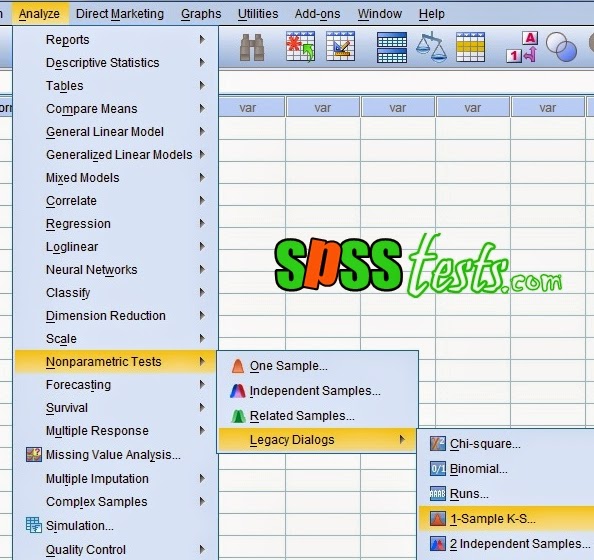
Distribución normal y Prueba de normalidad KolmogorovSmirnov y Shapiro
Step by Step Test of normality with the Kolmogorov-Smirnov Using SPSS. 1. Turn on the SPSS program and select the Variable View, next, in the Name write Competency and Performance. Ignore the other options. 2. The next step, click the Data View and enter research data in accordance with the competence and performance variables. 3.

How to test normality with the KolmogorovSmirnov Using SPSS SPSS Tests
so, formally, KS is inaccurate in this case. There is a version of KS test, called Lilliefors test, that tests normality of the distribution by comparing the data with a fitted normal distribution as we did above, but with a correction to give a more accurate approximation of the distribution of the test statistic. Example. (Lilliefors test.)

Testing for Normality of Distribution (the KolmogorovSmirnov test
The Kolmogorov-Smirnov test uses the maximal absolute difference between these curves as its test statistic denoted by D. In this chart, the maximal absolute difference D is (0.48 - 0.41 =) 0.07 and it occurs at a reaction time of 960 milliseconds. Keep in mind that D = 0.07 as we'll encounter it in our SPSS output in a minute.

Sage Research Methods Datasets Part 2 Learn to Use the Kolmogorov
Illustration of the Kolmogorov-Smirnov statistic. The red line is a model CDF, the blue line is an empirical CDF, and the black arrow is the KS statistic.. In statistics, the Kolmogorov-Smirnov test (K-S test or KS test) is a nonparametric test of the equality of continuous (or discontinuous, see Section 2.2), one-dimensional probability distributions that can be used to test whether a.

How to do Normal distribution tests in SPSS Kolmogorov Smirnov
Elevate your SPSS skills with our in-depth tutorial on the Kolmogorov-Smirnov One-Sample Test. Learn how to assess data normality and interpret the results e.

KolmogorovSmirnov Test (KS Test) of Normality for Each Level of
The Kolmogorov-Smirnov test (KS Test) is a bit more complex and allows you to detect patterns you can't detect with a Student's T-Test. From Wikipedia: "The Kolmogorov-Smirnov statistic quantifies a distance between the empirical distribution function of the sample and the cumulative distribution function of the reference distribution.

(PDF) SPSS KolmogorovSmirnov Test for Normality The Ultimate Guide
The test statistic and corresponding p-value for each test are shown: Kolmogorov Smirnov Test: Test statistic: .113; p-value: .200; Shapiro-Wilk Test: Test statistic: .967; p-value: .699; The p-values for both tests are not less than 0.05, which means we do not have sufficient evidence to say the variable points is not normally distributed.

Kolmogorov Smirnov Test of Normality Non Parametric Tests Using SPSS
The Shapiro-Wilk test examines if a variable is normally distributed in some population. Like so, the Shapiro-Wilk serves the exact same purpose as the Kolmogorov-Smirnov test. Some statisticians claim the latter is worse due to its lower statistical power. Others disagree.

Conducting a KolmogorovSmirnov Normality Test (KS Test) in SPSS YouTube
This video demonstrates how to conduct a One-Sample Kolmogorov-Smirnov Test in SPSS. The K-S Test compares a variable's distribution function with a specifie.

Normality test in SPSS KolmogorovSmirnov ShapiroWilk Normality
The One-Sample Kolmogorov-Smirnov Test procedure compares the observed cumulative distribution function for a variable with a specified theoretical distribution, which may be normal, uniform, Poisson, or exponential. The Kolmogorov-Smirnov Z is computed from the largest difference (in absolute value) between the observed and theoretical.

SPSS Tutorial 17 KolmogorovSmirnov (KS Test) YouTube
Kolmogorov Smirnov Test (KS Test) in SPSS. Step 1: Analyze → descriptive statistics → explore. Step 2: Move the variables you want to test for normality over to the Dependent List box. Step 3: (Optional if you want to check for outliers) Click Statistics, then place a check mark in the Outliers box.

Test de normalidad KolmogorovSmirnov ShapiroWilk con SPSS YouTube
SPSS runs two statistical tests of normality - Kolmogorov-Smirnov and Shapiro-Wilk. If the significance value is greater than the alpha value (we'll use .05 as our alpha value), then there is no reason to think that our data differs significantly from a normal distribution - i.e., we can reject the null hypothesis that it is non-normal.

Kolmogorov Smirnov Two Samples Test using SPSS YouTube
The two well-known tests of normality, namely, the Kolmogorov-Smirnov test and the Shapiro-Wilk test are most widely used methods to test the normality of the data. Normality tests can be conducted in the statistical software "SPSS" (analyze → descriptive statistics → explore → plots → normality plots with tests).

SPSS Kolmogorovsmirnov Analysis
We will next look at a statistical test to see if this backs up our visual impressions from the histogram. The Kolmogorov-Smirnov test is used to test the null hypothesis that a set of data comes from a Normal distribution. Te s t s o f N o r m a l i t y Kolmogorov-Smirnov Statistic df Sig. Science test score .025 5194 .000 a.

Kolmogorov Smirnov Test mit SPSS YouTube
SPSS Statistics allows you to test all of these procedures within Explore. The above table presents the results from two well-known tests of normality, namely the Kolmogorov-Smirnov Test and the Shapiro-Wilk Test. The Shapiro-Wilk Test is more appropriate for small sample sizes (< 50 samples), but can also handle sample sizes as large as.

Cara Melakukan Uji Normalitas Kolmogorov Smirnov Dengan Spss Spss
The Kolmogorov-Smirnov test is a nonparametric goodness-of-fit test and is used to determine wether two distributions differ, or whether an underlying probability distribution differes from a hypothesized distribution. It is used when we have two samples coming from two populations that can be different. Unlike the Mann-Whitney test and the Wilcoxon test where the goal is to detect the.